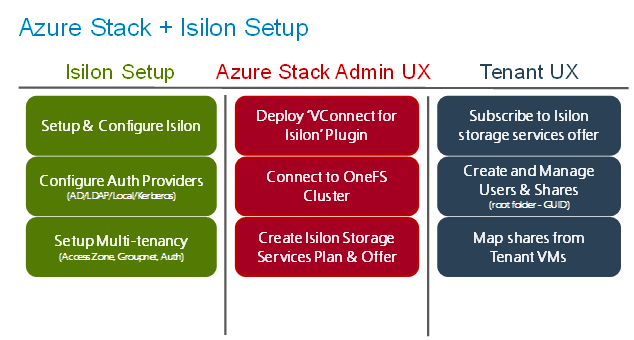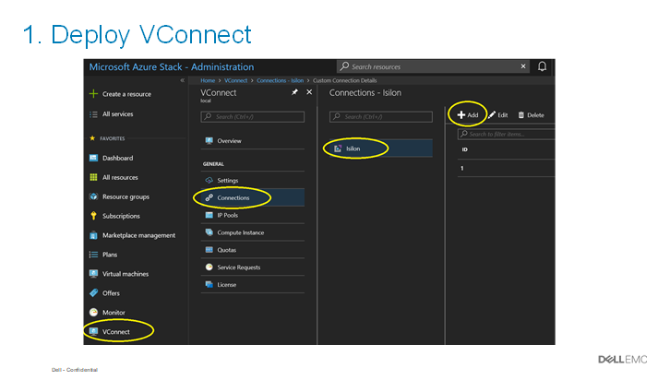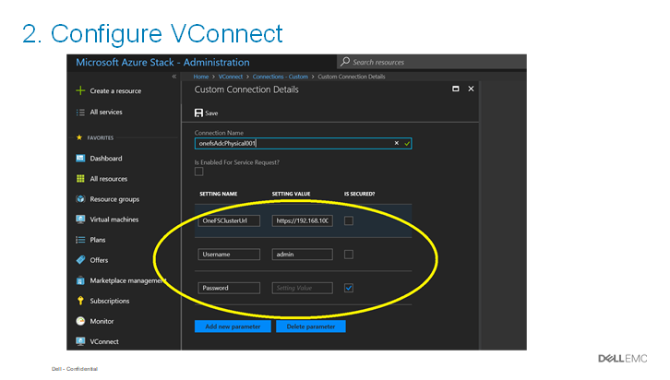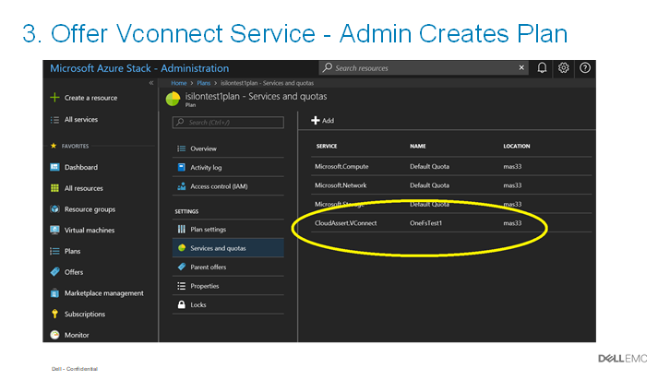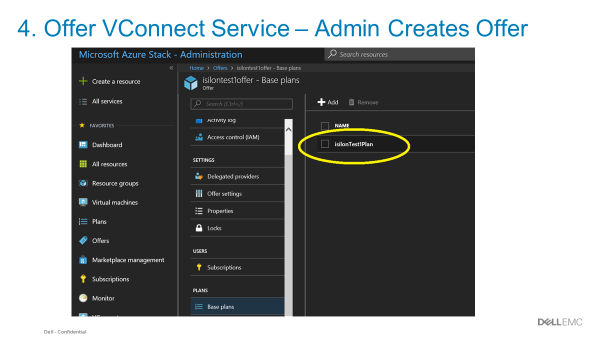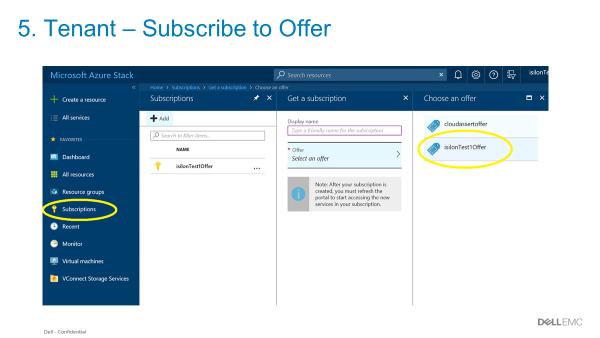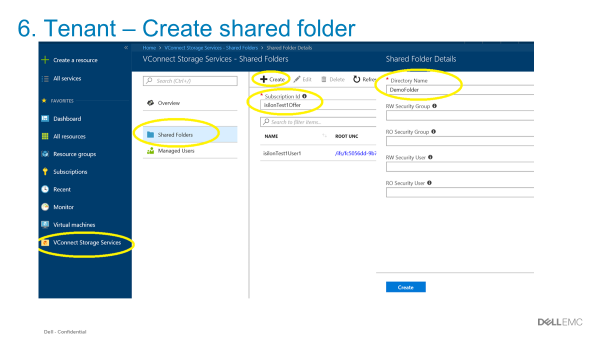

Azure Stack "Storage as a Service" with Isilon NAS
Mon, 17 Aug 2020 19:09:23 -0000
|Read Time: 0 minutes
Azure Stack "Storage as a Service" with Isilon NAS
Azure Stack
Azure Stack is designed to help organizations deliver Azure services from their own data center. By allowing end users to ‘develop once and deploy anywhere' (public Azure or on premises). Customers now can take full advantage of cloud for various applications that could not live in cloud otherwise, may it be due to regulations, data sensitivity, edge use cases, or location of data that prevents them from using public cloud.
Dell EMC co-engineers this solution with Microsoft with added value in automation of deployments, patches and updates along with integration of various key solutions to meet our customers’ holistic needs. One such value add is enabling our Azure stack customers to expand file storage.
Why should you care? - Because of the storage limitation!
Storage Limitation
Azure Stack storage is a set of cloud storage services that includes blobs, tables and queues which are consistent with public Azure storage services, built on Storage Spaces Direct (S2D). It is important to note that while 'file storage' is supported in public Azure, it is currently not supported on Azure Stack. This means that any tenant workload that needs to access files via SMB/NFS has to use external NAS storage residing outside the stack. Additionally, since Azure Stack is built on a hyper-converged architecture, it inherently limits the capacity of S2D storage.
What is the solution? - Isilon. Though there are many external file storage options available, Isilon is an excellent option for the following reasons.
Isilon
Isilon is a scale out network-attached storage (NAS) platform offered by Dell EMC for high-volume storage, backup and archiving of unstructured data. While Isilon offers extremely high scalability that is highly cost effective, it provides enterprise class features such as:
- Performance monitoring with InsightIQ
- Tiering of data with SmartPools
- Quota management with SmartQuotas
- Data protection with SnapshotIQ
- Data replication with SyncIQ
- High availability and load balancing with SmartConnect
- Deduplication with SmartDedupe
- Data retention with SmartLock
- Stringent compliance and governance needs through WORM capability
- Last but not the least, seamless tiering of cold or frozen data to public Azure storage with CloudPools
Isilon supports SMB, NFS, HTTPS object storage, and HDFS, among other protocols. And, there are three different Isilon platform families to meet the performance needs of the data, all running Isilon OneFS:
- The all-flash F-series, focusing on extreme performance and scalability for unstructured data applications and workloads
- The hybrid H-series, which seek to balance performance and capacity
- The archive A-series, for both active and deep archive storage
Configuring your file share
Ok, how do you set up such that tenant workloads can access external file shares? - Simple. If you have a NAS such as Isilon sitting outside of the stack, your tenants can directly map the file shares via SMB/NFS as long as the network connectivity is set up. It requires careful consideration, planning and administration.
Your feedback
Whether you are an existing Isilon customer who purchasing Azure stack or a new Azure stack customer that needs file storage for your documents, back up vault or running analytics workload with HDFS, you asked us for a simple and scalable storage solution that is easy to manage with Azure stack. We heard you!
Multi-tenancy and Administration complexity
Isilon supports multi-tenancy such that, each Azure stack tenant can access specific sub-folders of Isilon storage under the single namespace. You can set up access-zones, network segmentation with groupnets and subnets, authentication providers (AD/LDAP, etc.) along with quotas and policies for each tenant on Isilon. While it may not be complex to set up, ongoing administration can be non-trivial. For example, when Isilon and Azure stack are managed independently, and when the cloud admin needs to onboard new a tenant or offboard a tenant or one of the tenants need more capacity or change backup configurations, etc. You have to manage this workflow carefully with SLA and must plan for the overhead.
An ideal approach to simplify or reduce this overhead is to give autonomy to cloud admins to manage tenants’ storage. Cloud admins ought to be able to simply manage storage capacity and storage services with respect to their tenants. Furthermore, extend the flexibility to tenants to self-manage their storage space and users within their respective org. Needless to say, this must be done with a consistent Azure user experience.
That is what we have done with our VConnect plug-in for Isilon and Azure Stack.
How does it work?
Once Isilon is setup and multi-tenancy is enabled by Isilon admins, Azure stack admins can deploy our VConnect plug-in for Isilon and enable it through plans and offers for their tenants. Tenants now can subscribe to the storage services under that plan and self-manage storage capacity, users and access.
Step by Step Instruction
A detailed step by step guide to setup and use VConnect plug-in for Isilon is described below.
Opportunities
Whether you are a service provider or an enterprise customer, you now have the ability to offer Storage-as-a-Service to your customers with enterprise class storage features such as high availability and data protection, security and more with Azure Stack and Isilon.
How to order
This solution is currently available for purchase through our solution partner CloudAssert. You can reach out to your Azure Stack sales specialist to buy this.
For inquiries, questions and comments, please reach out to Dell EMC Azure Stack product manager Karthik Angamuthu at Karthik_Angamuthu@dell.com.
Related Blog Posts

The challenging Edge: Dell Technologies to the rescue with Azure Stack Hub – Tactical
Mon, 26 Jul 2021 12:46:04 -0000
|Read Time: 0 minutes
Some context for a turbulent environment
In August 31, 2017, Microsoft launched Azure Stack Hub and enabled a true hybrid cloud operating model to extend Azure services on-premises. An awesome and long expected milestone at that time!
Implementing Azure Stack Hub in our customers’ datacenters under normal circumstances is a pretty straightforward process today if you choose our Dell EMC Integrated System for Microsoft Azure Stack Hub.
But there are certain cases where delivering Azure Stack Hub may be complex (or even impossible), especially in scenarios such as:
 Edge scenarios: semi-permanent or permanent sites where there is no planned decommissioning, that can include:
Edge scenarios: semi-permanent or permanent sites where there is no planned decommissioning, that can include:
- IoT Applications: Device provisioning, tracking and management applications
- Efficient field operations: Disaster Relief, humanitarian efforts, embassies
- Smarter management of mobile fleet assets: Utility and maintenance vehicles

- Tactical scenarios: strategic sites stood up for a specific task, temporary or permanent, that can experience:
- Limited/restricted connectivity: submarines, aircraft, and planes
- Harsh Conditions: combat zones, oil rigs, mine shafts
The final outcome in these environments remains the same: provide always-on cloud services everywhere from a minimal set of local resources.
The question is… how do we make this possible?
The answer is: Dell EMC Integrated System for Microsoft Azure Stack Hub – Tactical
Dell Technologies, in partnership with Microsoft and Tracewell Systems, has developed Dell EMC Integrated System for Microsoft Azure Stack Hub – Tactical (aka Azure Stack Hub – Tactical): a unique ruggedized and field-deployable solution for Azure Stack tactical edge environments.
Azure Stack Hub – Tactical extends Azure-based solutions beyond the traditional data center to a wide variety of non-standard environments, providing a local Azure consistent cloud with:
- Limited or no network connectivity
- Fully mobile, or high portability (“2-person lift”) requirements
- Harsh conditions requiring military specifications solutions
- High security requirements, with optional connectivity to Azure Government and Azure Government Secret
Azure Stack Hub – Tactical is functionally and electrically identical to Azure Stack Hub All-Flash to ensure interoperability. It includes custom engineered modifications to make the whole solution fit into just three ruggedized cases that are only23.80 inches wide, 41.54 inches high, and 25.63 inches deep.
The smallest Azure Stack Hub – Tactical configuration comprises one management case plus two compute cases, each of them containing:
- Management case:
- 1 x T-R640 HLH management server (2U)
- 1 x N3248TE-ON management switch (1U)
- 2 x S5248F-ON Top-of-Rack switches (1U each)
- Total weight: 146 lbs.
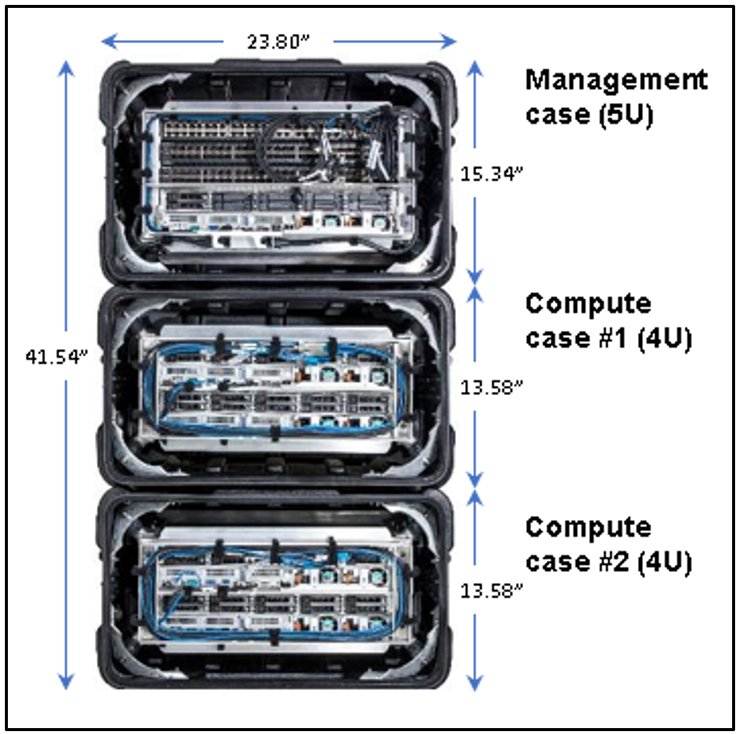
- Compute case:
2 x T-R640 servers, based on Dell EMC PowerEdge R640 All-Flash server adapted for tactical use (2U each)
Two configuration options for compute servers:
- Low:
- 2 x Intel 5118 12-core processors
- 384 GB memory
- 19.2TB total raw SSD capacity
- High:
- 2 x Intel 6130 16-core processors
- 768GB memory
- 38.4TB total raw SSD capacity
- Total weight: 116 lbs.
- Heater option for extended temperature operation support:
- The Tactical devices are designed to meet MIL-STD-810G specification
- Dell Technologies in collaboration with Tracewell systems has designed a fully automated heater which, when fully integrated, can provide supplemental heating to the device when needed.
Compute cases can grow up to 8, for a total of 16 servers (in 4-node increments) -- the scale unit maximum mandated by Microsoft.
You can read the full specifications here.
Azure Stack Hub – Tactical is a turnkey end to end engineered solution designed, tested, and sustained through the entire lifespan of all of its hardware and software components.
It includes non-disruptive operations and automated full stack life cycle management for on-going component maintenance, fully coordinated with Microsoft’s Update process.
Customers also benefit from a simplified one call support model across all solution components.
Conclusion
Desperate “edge-cuts” must have desperate “tactical-cures”, and that is exactly what Dell EMC Integrated System for Microsoft Azure Stack Hub – Tactical delivers to our customers for edge environments and extreme conditions.
Azure Stack Hub – Tactical resolves the challenges of providing Azure cloud services everywhere by allowing our customers to add/remove deployments with relative ease through an automated, repeatable, and predictable process requiring minimal local IT resources.
Thanks for reading and stay tuned for more blog updates in this space by visiting Info Hub!

GPU-Accelerated AI and ML Capabilities
Mon, 14 Dec 2020 15:37:06 -0000
|Read Time: 0 minutes
Dell EMC Integrated System for Microsoft Azure Stack Hub has been extending Microsoft Azure services to customer-owned data centers for over three years. Our platform has enabled organizations to create a hybrid cloud ecosystem that drives application modernization and to address business concerns around data sovereignty and regulatory compliance.
Dell Technologies, in collaboration with Microsoft, is excited to announce upcoming enhancements that will unlock valuable, real-time insights from local data using GPU-accelerated AI and ML capabilities. Actionable information can be derived from large on-premises data sets at the intelligent edge without sacrificing security.
Partnership with NVIDIA
Today, customers can order our Azure Stack Hub dense scale unit configuration with NVIDIA Tesla V100S GPUs for running compute-intensive AI processes like inferencing, training, and visualization from virtual machine or container-based applications. Some customers choose to run Kubernetes clusters on their hardware-accelerated Azure Stack Hub scale units to process and analyze data sent from IoT devices or Azure Stack Edge appliances. Powered by the Dell EMC PowerEdge R840 rack server, these NVIDIA Tesla V100S GPUs use Discrete Device Assignment (DDA), also known as GPU pass-through, to dedicate one or more GPUs to an Azure Stack Hub NCv3 VM.
The following figure illustrates the resources installed in each GPU-equipped Azure Stack Hub dense configuration scale unit node.
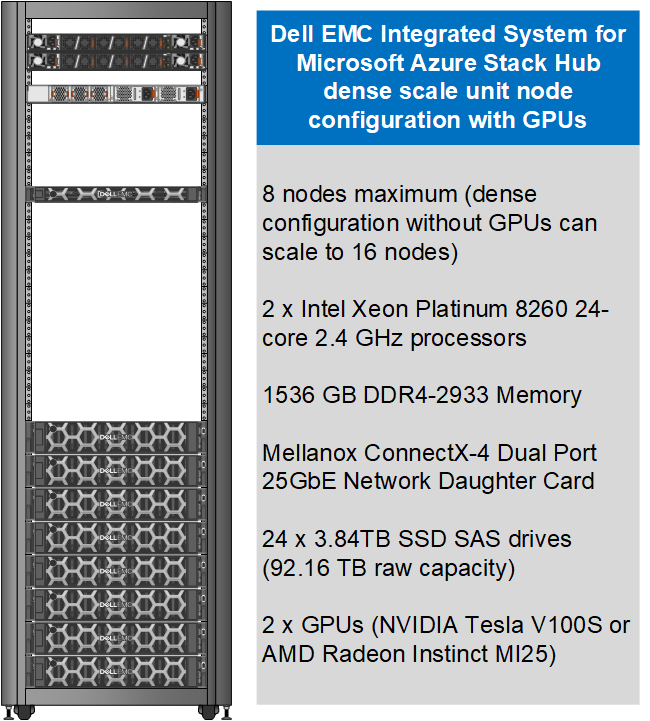
This month, our Dell EMC Azure Stack Hub release 2011 will also support the NVIDIA T4 GPU – a single-slot, low-profile adapter powered by NVIDIA Turing Tensor Cores. These GPUs are perfect for accelerating diverse cloud-based workloads, including light machine learning, inference, and visualization. These adapters can be ordered with Dell EMC Azure Stack Hub all-flash scale units powered by Dell EMC PowerEdge R640 rack servers. Like the NVIDIA Tesla V100S, these GPUs use DDA to dedicate one adapter’s powerful capabilities to a single Azure Stack Hub NCas_v4 VM. A future Azure Stack Hub release will also enable GPU partitioning on the NVIDIA T4.
The following figure illustrates the resources installed in each GPU-equipped Azure Stack Hub all-flash configuration scale unit node.
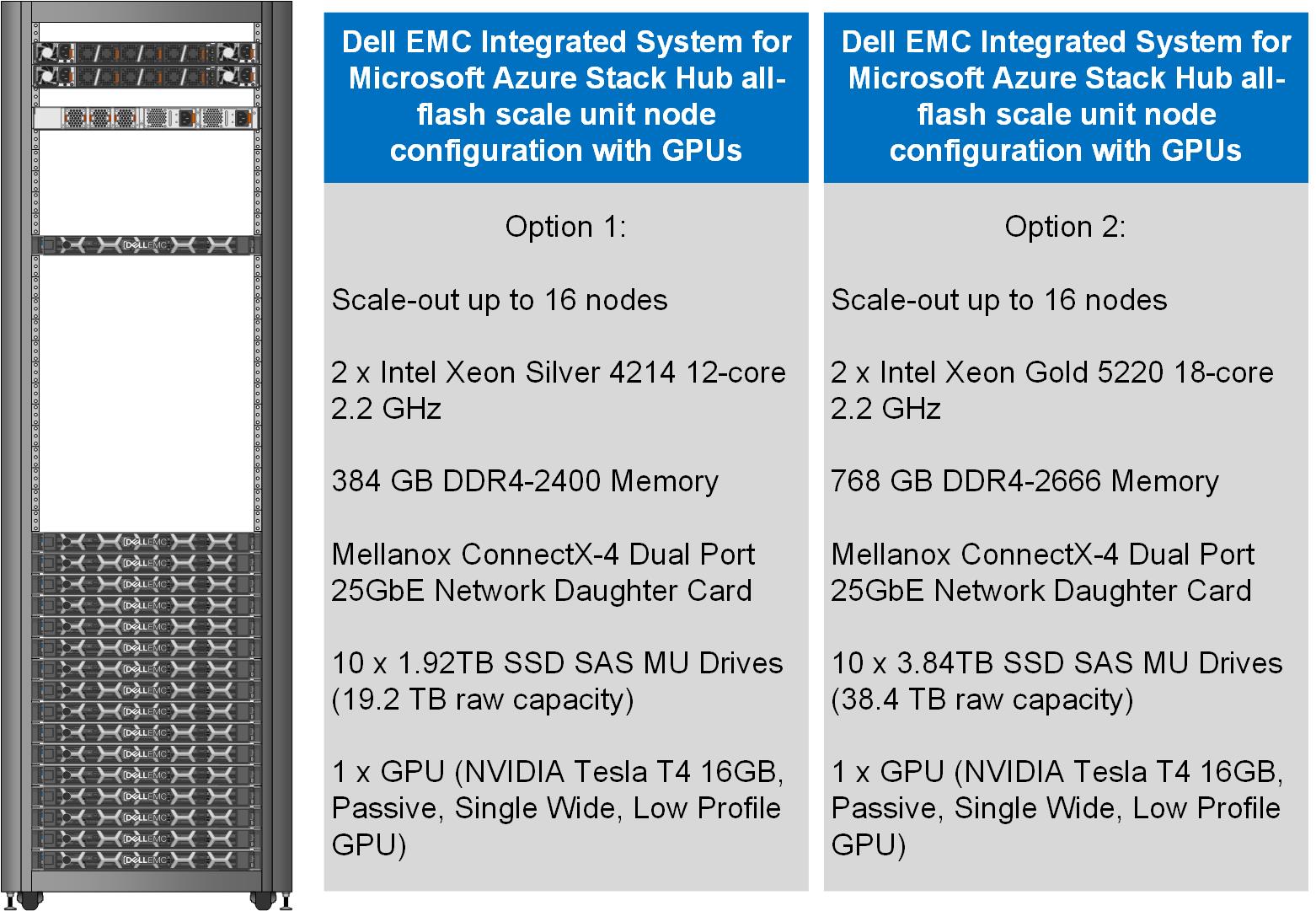
Partnership with AMD
We are also pleased to announce a partnership with AMD to deliver GPU capabilities in our Dell EMC Integrated System for Microsoft Azure Stack Hub. Available today, customers can order our dense scale unit configuration with AMD Radeon Instinct MI25 GPUs aimed at graphics intensive visualization workloads like simulation, CAD applications, and gaming. The MI25 uses GPU partitioning (GPU-P) technology to allow users of an Azure Stack Hub NVv4 VM to consume only a portion of the GPU’s resources based on their workload requirements.
The following table is a summary of our hardware acceleration capabilities.
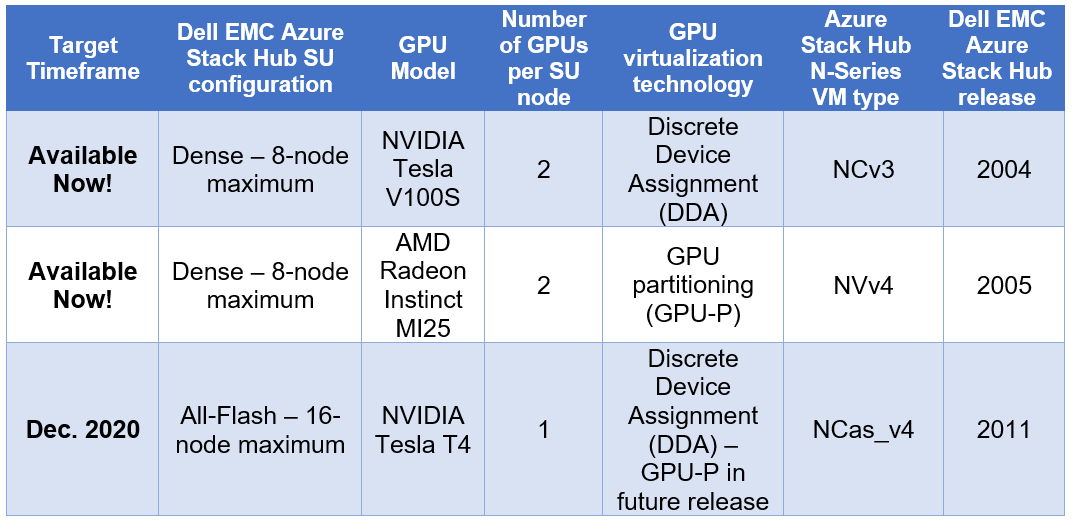
An engineered approach
Following our stringent engineered approach, Dell Technologies goes far beyond considering GPUs as just additional hardware components in the Dell EMC Integrated System for Microsoft Azure Stack Hub portfolio. We apply our pedigree as leaders in appliance-based solutions to the entire lifecycle of all our scale unit configurations. The dense and all-flash scale unit configurations with integrated GPUs are designed to follow best practices and use cases specifically with Azure-based workloads, rather than workloads running on traditional virtualization platforms. Dell Technologies is also committed to ensuring a simplified experience for initial deployment, patch and update, support, and streamlined operations and monitoring for these new configurations.
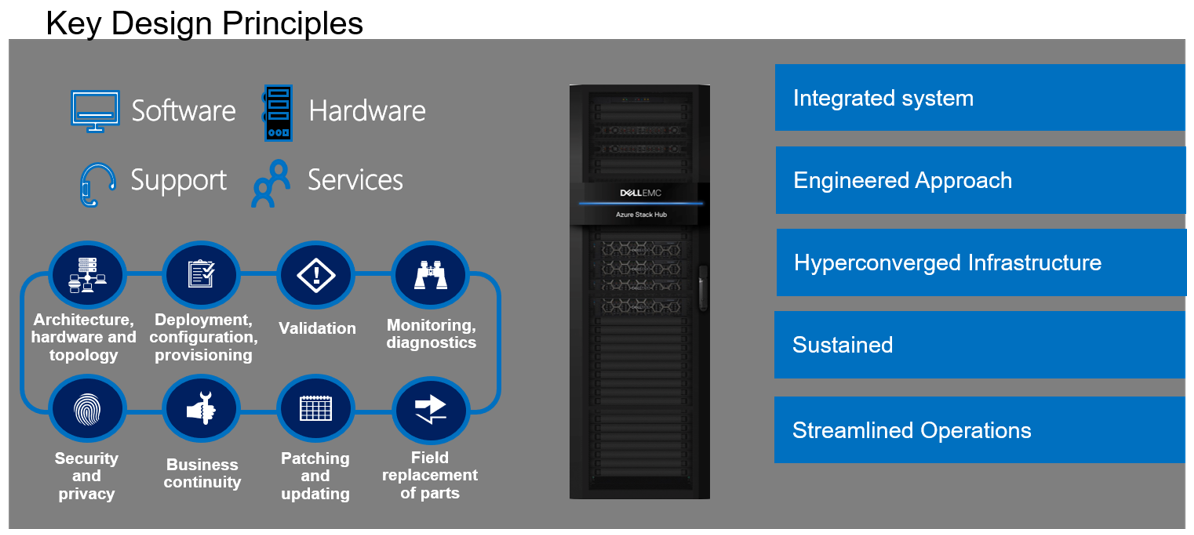
Additional considerations
There are a couple of additional details worth mentioning about our new Azure Stack Hub dense and all-flash scale unit configurations with hardware acceleration:
- The use of the GPU-backed N-Series VMs in Azure Stack Hub for compute-intensive AI and ML workloads is still in preview. Dell Technologies is very interested in speaking with customers about their use cases and workloads supported by this configuration. Please contact us at mhc.preview@dell.com to speak with one of our engineering technologists.
- The Dell EMC Integrated System for Microsoft Azure Stack Hub configurations with GPUs can be delivered fully racked and cabled in our Dell EMC rack. Customers can also elect to have the scale unit components re-racked and cabled in their own existing cabinets with the assistance of Dell Technologies Services.
Resources for further study
- At the time of publishing this blog post, only the NCv3 and NVv4 VMs are available in the Azure Stack Hub marketplace. The NCas_v4 currently is not visible in the portal. Please proceed to the Azure Stack Hub User Documentation for more information on these VM sizes.
- Customers may want to explore the Train Machine Learning (ML) model at the edge design pattern in the Azure Hybrid Documentation. This may prove to be a good starting point for putting this technology to work for their organization.
- Customers considering running AI and ML workloads on Dell EMC Integrated System for Microsoft Azure Stack Hub can also greatly benefit from storage-as-a-service with Dell EMC PowerScale. PowerScale can help enable faster training and validation of AI models, improve model accuracy, drive higher GPU utilization, and increase data science productivity. Visit Artificial Intelligence with Dell EMC PowerScale for more information.



